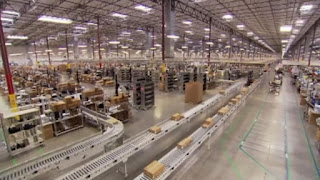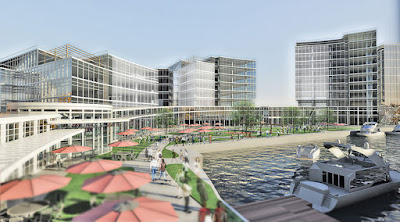Circumstantial evidence suggests the replacement for the 687,000-square-foot shopping mall will be a massive distribution facility for the online retail giant Amazon. Called a Fulfillment Center, the facility would measure at least 650,000 square feet and possibly be as large as 1 million square feet. Based on similar projects elsewhere in Ohio, it would represent a capital investment in facilities and equipment of more than $100 million and result in the hiring of more than 600 permanent jobs.
AMAZON FULFILLMENT CENTER
Two similarly sized Amazon Fulfillment Centers that opened in 2016 outside Columbus now employ 5,000 people total, or roughly double what was originally projected. An 855,000-square-foot Amazon Fulfillment Center in Etna Township employs about 3,000 people while a 1 million-square-foot Amazon facility in Obetz employs more than 2,000 workers.
According to public records, Euclid's Planning & Zoning Commission on May 9 (see last item on the agenda) will consider at its regular meeting a proposed zoning change by Seefried Industrial Properties, Inc., an Atlanta real estate developer. The agenda reads:
Seefried Industrial Properties, Inc., prospective purchaser, on behalf of Beverly Terrace Ltd, SNS Properties LLC, MCM Superior-Glen Apartments, Lee-Silsby Associates, and Gerome’s Grove, has submitted an application requesting the rezoning of a group of parcels from a U4-Local Retail or Wholesale Store District to a U6-Industrial and Manufacturing District. The proposed rezoning is for eight irregularly shaped parcels totaling 2,866,248 square feet (65.80 acres) in size.If the rezoning and other permits are approved, Seefried will execute pending purchase agreements with the five property owners listed above to acquire nine parcels. Not only would Euclid Square Mall be demolished for this distribution facility, but so would four long-closed outlot structures. These include a Toys 'R' Us store, Stop-n-Shop grocery store, Red Lobster restaurant and a bank according to documents submitted to the City of Euclid by Seefried.
PROPOSED DISTRIBUTION FACILTY
EXISTING MALL AREA/PROPERTY OWNERS
While Seefried develops facilities for other clients such as Pepsi, PPG, Home Depot, and others, recent indicators suggest the client for the Euclid project is Amazon. The indicators include:
- Seefried's largest client is Amazon, as Seefried is the real estate developer for dozens of Amazon distribution center projects around the country;
- A source says Amazon is opening "three or four" distribution centers around Cleveland but could not identify their locations;
- Amazon is opening a Twinsburg sorting facility in a 248,000-square-foot building at the former Chrysler automotive plant;
- Amazon is also leasing 80,000 square feet of space in Euclid's Bluestone Business Center, across East 260th Street from Euclid Square Mall, for a delivery station;
- This facility's size is consistent with Amazon's largest distribution facilities (Fulfillment Centers), including its first two in Ohio as described above;
- Amazon enjoys having its facilities receive electricity either directly or indirectly from wind turbines and Euclid's location along Lake Erie makes it ideally suited for wind power. Euclid already has four companies whose facilities are directly powered by wind.
The Euclid Square Mall site is next to Interstate 90, State Route 2 and only several miles from Interstate 271 as well as CSX's intermodal rail terminal at Collinwood Yards. It is probably the largest, cleanest, developable property so close to the urban core of the Greater Cleveland area.
Euclid city officials are to be commended for re-purposing a large site that was made obsolete by the changing retail business. They further deserve kudos for ensuring that the city will benefit from the very business activity that replaced the shopping mall -- E-commerce. Too often, very large distribution centers find sprawling, clean properties at the urban fringe, far from labor pools that need jobs and established communities that need to replace lost tax revenues.
After World War II, Chase Brass & Copper Co. had two large plants on either side of East 260th Street in Euclid. One was sheet mill on Babbitt Road and the other a tube mill on East 260th (formerly Upson Road). The tube mill was shut down in the middle of a strike in 1973. In 1975 the mill was demolished for Euclid Square Mall, built by Jacobs, Visconsi & Jacobs (now the Jacobs Group) and opened on March 1, 1977. The mall's last retailer, a Dillards outlet store, closed in September 2013.
- END -























